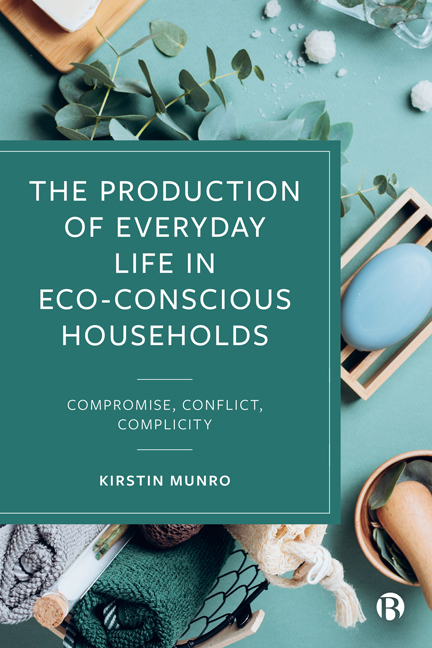Book contents
- Frontmatter
- Dedication
- Contents
- Acknowledgments
- 1 Introduction: “This Can’t Be All Up to Me”
- 2 Eco-Conscious Household Production and Capitalist Society
- 3 Priorities in Eco-Conscious Households
- 4 Resources and Constraints in Eco-Conscious Households
- 5 Managing Household Waste
- 6 Cleanliness and Comfort
- 7 Doing Their Own Research
- 8 Conflict
- 9 “How Do We Live with Ourselves?”
- 10 Conclusion: “We Have Met the Enemy and He Is Us”
- Notes
- Index
6 - Cleanliness and Comfort
Published online by Cambridge University Press: 18 January 2024
- Frontmatter
- Dedication
- Contents
- Acknowledgments
- 1 Introduction: “This Can’t Be All Up to Me”
- 2 Eco-Conscious Household Production and Capitalist Society
- 3 Priorities in Eco-Conscious Households
- 4 Resources and Constraints in Eco-Conscious Households
- 5 Managing Household Waste
- 6 Cleanliness and Comfort
- 7 Doing Their Own Research
- 8 Conflict
- 9 “How Do We Live with Ourselves?”
- 10 Conclusion: “We Have Met the Enemy and He Is Us”
- Notes
- Index
Summary
The social and cultural meanings of cleanliness and comfort have evolved over time, generally in ways that demand more resources (Shove 2003). The temperatures that feel comfortable indoors, and the actions people take and the equipment they use to remain comfortable, are matters of cultural expectations and social norms, but the equipment and infrastructures in homes recursively reinforces expectations about how people should feel indoors and what steps they ought to take to feel that way. And ironically, as new supposedly time-saving domestic technologies emerge, cleaning practices and the demand for cleanliness have changed in ways that demand more unwaged time rather than less (Cowan 1983). Changes in infrastructures and technologies, like central heating and in-home washing machines, make these evolutions in cultural expectations possible, and even recursively reinforce the normalcy of these expectations. So while cleanliness and comfort involve mundane habits that are easily taken for granted, my informants have made changes to conventional ways of getting things done to make their practices more sustainable. In some cases, these changes take more unwaged time (as Cowan 1983 documents) but in other cases these changes—intriguingly—result in less unwaged time devoted to mundane household practices.
Cleanliness
Shove (2003, 10) says that demand escalators don't run backwards, but the ways that my informants have changed their showering, laundry, and household cleaning habits provide concrete examples of very real demanddecreasing changes in practices and accompanying changes in the meaning of cleanliness. Some of these changes involve taking additional unwaged time to perform cleaning activities in more labor-intensive ways that avoid the use of energy or “chemicals,” or purchasing special cleaning products, but other changes involve simply reducing the frequency of cleaning, thus actually reducing the amount of unwaged work involved.
Showering
The history of personal hygiene in the United States by Bushman and Bushman (1988) reveals that the meaning and practices associated with personal cleanliness have changed substantially since the 18th century, when even affluent Americans might never bathe, cleaning themselves instead with an occasional sponge bath—a wet cloth and no soap. The accompanying infrastructure—a washbasin—was still a fairly rare item to find in U.S. homes, and bathtubs were completely absent. By 1900, bathing practices had changed such that most Americans bathed fairly regularly, though still far less than we do today, as bodily cleanliness began to take on new social and moral meanings.
- Type
- Chapter
- Information
- The Production of Everyday Life in Eco-Conscious HouseholdsCompromise, Conflict, Complicity, pp. 96 - 120Publisher: Bristol University PressPrint publication year: 2023

